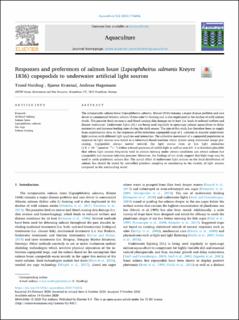| dc.contributor.author | Nordtug, Trond | |
| dc.contributor.author | Kvæstad, Bjarne | |
| dc.contributor.author | Hagemann, Andreas | |
| dc.date.accessioned | 2022-10-19T07:29:01Z | |
| dc.date.available | 2022-10-19T07:29:01Z | |
| dc.date.created | 2020-11-27T15:12:00Z | |
| dc.date.issued | 2021 | |
| dc.identifier.citation | Aquaculture, 532, 736036, 1-8 | en_US |
| dc.identifier.issn | 0044-8486 | |
| dc.identifier.uri | https://hdl.handle.net/11250/3026900 | |
| dc.description.abstract | The ectoparasitic salmon louse (Lepeophtheirus salmonis, Krøyer 1836) remains a major disease problem and cost driver in commercial Atlantic salmon (Salmo salar L) farming and is also implicated in the decline of wild salmon stocks. The parasite feeds on mucus and blood causing skin damage on its host (i.e. leads to reduced welfare and disease resistance). Underwater lights (UL) are being used regularly in open-cage salmon aquaculture to delay maturation and increase feeding rates during the dark season. The aim of this study has therefore been to supply basic experimental data on the responses of the infectious copepodid stage of L. salmonis to discrete underwater light sources with different light qualities and intensities. The collective movement of a copepodid population in response to light sources was tested in a laboratory-based machine vision system using automated image processing. Copepodids always moved towards the light source even at low light intensities (1.5 × 10−3 μmol m−2 s−1) within a broad spectrum of visible light as well as near-UV. It is therefore plausible that subsea light sources frequently used in salmon farming under certain conditions can attract salmon lice copepodids and increase infection pressure. Moreover, the findings of our study support that light traps may be used to catch planktonic salmon lice. The actual effect of underwater light sources on the local distribution of salmon lice should be tested by controlled plankton sampling or monitoring in the vicinity of light sources compared to the surrounding water. | en_US |
| dc.language.iso | eng | en_US |
| dc.publisher | Elsevier | en_US |
| dc.rights | Navngivelse 4.0 Internasjonal | * |
| dc.rights.uri | http://creativecommons.org/licenses/by/4.0/deed.no | * |
| dc.subject | Salmon farming | en_US |
| dc.subject | Sea cage | en_US |
| dc.subject | Salmon louseLepeophtheirus salmonis | en_US |
| dc.subject | Artificial lighting | en_US |
| dc.title | Responses and preferences of salmon louse (Lepeophtheirus salmonis Krøyer 1836) copepodids to underwater artificial light sources | en_US |
| dc.type | Peer reviewed | en_US |
| dc.type | Journal article | en_US |
| dc.description.version | publishedVersion | en_US |
| dc.rights.holder | © 2020 The Authors. Published by Elsevier B.V. | en_US |
| dc.source.pagenumber | 8 | en_US |
| dc.source.volume | 532 | en_US |
| dc.source.journal | Aquaculture | en_US |
| dc.identifier.doi | 10.1016/j.aquaculture.2020.736036 | |
| dc.identifier.cristin | 1853465 | |
| dc.source.articlenumber | 736036 | en_US |
| cristin.ispublished | true | |
| cristin.fulltext | original | |
| cristin.qualitycode | 2 | |

